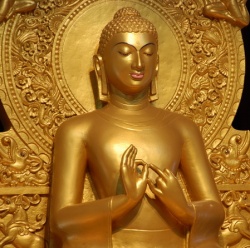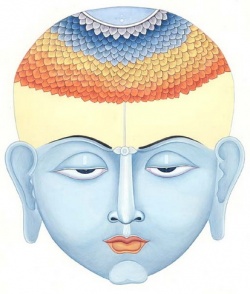The Importance of the Guru
By Lama Yeshe
The Internal and External Guru
The tantric texts often mention that all realisations come from the guru. This is true, but we have to understand that 'guru' has two different levels of meaning. The relative, objective guru is the teacher who, by communicating with us in different ways, shows us how to act so that we can discover our own totality. But on a deeper, more subjective level, our guru is none other than our own inner wisdom, our own fundamental clarity of mind.
Look at the different ways in which people respond to the same spiritual teachings by the same teacher. One person may not even understand intellectually the concepts contained in the teaching. Another may be able to understand them but be unable to penetrate their inner meaning. And there are those who can reach beyond the mere words and concepts and experience total unification with the teacher's wisdom and compassion. These reactions are all due to the various individuals' having achieved different levels of intellectual and spiritual evolution. The more in touch they are with their own internal guru, the more profound their understanding of the teachings will be.
Practically speaking, there is only so much the relative, external guru can do for us; he or she cannot guarantee that we gain insight and realisations. But our inner guru, our own clear wisdom, can accomplish everything. The practice of guru-yoga, therefore, is primarily a method for learning how to listen to this inner guru.
Ordinarily, even though we do posses this inner voice of wisdom, we do not listen to it. We do not even hear it! We are too busy listening to the garbage conversation of our gross dualistic minds. We are so accustomed to this that even when wisdom does arise, as an intuitive insight, we often reject it. By practising guru-yoga we are able progressively to cut through our superficial ways of relating to the world and make contact with the innate wisdom at the heart of our being. When we have done this, then we can communicate deeply with the outer guru as well. But as long as we are out of touch with out inner guru, no matter how profound the teachings of the outer guru may be, we will never be able to integrate them.
But we should not interpret this to mean that the external, relative guru is unimportant. This is not true; he or she is vitally important. Although it is true that the tantric teachings of Shakyamuni Buddha have been in existence for 2500 years, do they exist for us if we have not yet met a qualified tantric master? Are they real for us or not? Despite the extensive explanations of such realised adepts as Naropa, Marpa and Tsong Khapa, can we say that tantra is a reality for us before someone has introduced it to us? Of course not. And the same is true for the teachings of sutra as well; the fact that Buddha taught the Four Noble Truths a long time ago does not make them true for us. They only become part of our reality once we have realised them, and this depends upon having met a guru who can show us their truth clearly in a way we can understand. If we do not have the living example and inspiration of the external guru, our inner wisdom win remain weak and undeveloped.
The Spiritual Guide and Model
For the teachings of enlightened beings to reach us and for their insights to make an impression on our mind, there should be an unbroken lineage of successive gurus and disciples carrying these living insights down to the present day. As a member of this lineage, the spiritual guide who makes the Four Noble Truths come alive for you does so through his or her inspiration or blessings. Familiar with your character and aptitudes, such a guide can make these noble truths so clean clear for you that your mind itself becomes the path of realisation. This is what is meant by inspiration or blessing, just this. And the practice of guru-yoga, or guru devotion, is nothing more than opening ourselves to this inspiration.
Furthermore, we need an experienced guide to show us exactly how to put the teachings we receive into practice. We will not get anywhere if we try to learn from a book, hoping to figure things out by ourselves. The information may all be there, but nearly all tantric texts are cryptic, revealing their meaning only when studied together with the explanations of skilled practitioners, and it is not easy to know just how to go about implementing this information. We need someone to show us, to give us a practical demonstration. This person is the guru.
The need for such an experienced guide is crucial when it comes to following tantra because tantra is a very technical, internally technical, system of development. We have to be shown how everything fits together until we actually feel it for ourselves. Without the proper guidance we would be as confused as someone who instead of getting a Rolls Royce gets only a pile of unassembled parts and an instruction book. Unless the person were already a highly skilled mechanic, he or she would be completely lost.
The main reason that religion in both the East and the West has degenerated so much nowadays is the rarity of meeting good spiritual examples. If people never meet highly realised beings they have no way of knowing the limitless possibilities of their own human consciousness. It is not enough that there are texts recording the deeds and accomplishments of past masters. By themselves, such stories cannot inspire us very much. In fact, they may only increase our feeling of remoteness: 'Buddha and Jesus lived such a long time ago', we may think, 'and their purity belongs to another age. It is impossible for someone like myself living in this degenerate twentieth century to attain anything resembling their level of purity.' Or we may reject these accounts of past masters completely, dismissing them as fairy tales fit only for gullible children. The only way we can lay to rest these feelings of doubt, incapability and cynicism is by coming face-to-face with someone who has activated his or her highest potential. Only then do we have an example of purity and spiritual evolution whom we can actually see and relate to ourselves.
Thus the outer guru is of utmost importance. We need the example of someone who, while human like ourselves, has developed beyond the bounds of what we presently think possible. When we see someone who has reached beyond selfishness, who has transcended the petty concerns of this world while still living in the world, who speaks and acts from intuitive wisdom and who is truly dedicated to the welfare of others, then we can have faith and conviction that these attainments are possible for ourselves as well. Otherwise, if our only models are those of greed and aggression, our vision of what we are and what we can become will be sadly limited.
A good model is important not only for those interested in following a spiritual path. The most urgent need in the world today is for peace and harmony, and we all feel this need, whether we call ourselves religious or not. But peace cannot be brought about through mere words, and it certainly will not come about through force. Instead, we need the example of those who have made peace and harmony the centre of their lives. It is only the example of such people, living lives of strength and purity, that will convince a disillusioned world that peace - internal and external - is truly possibly here and now.

